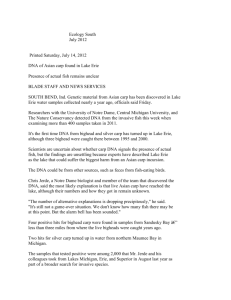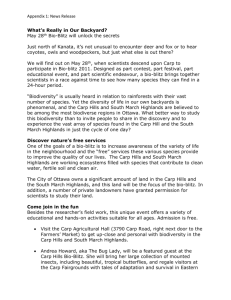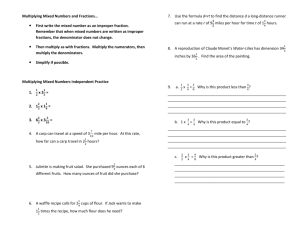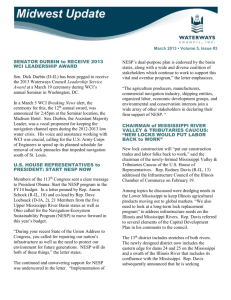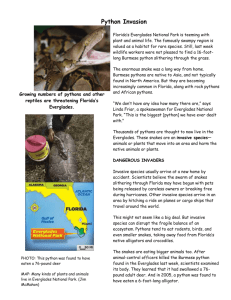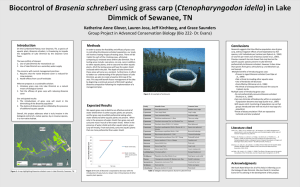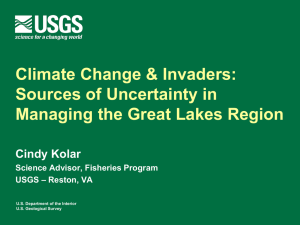D - Welcome to the Personal Website of Roger M Cooke
advertisement
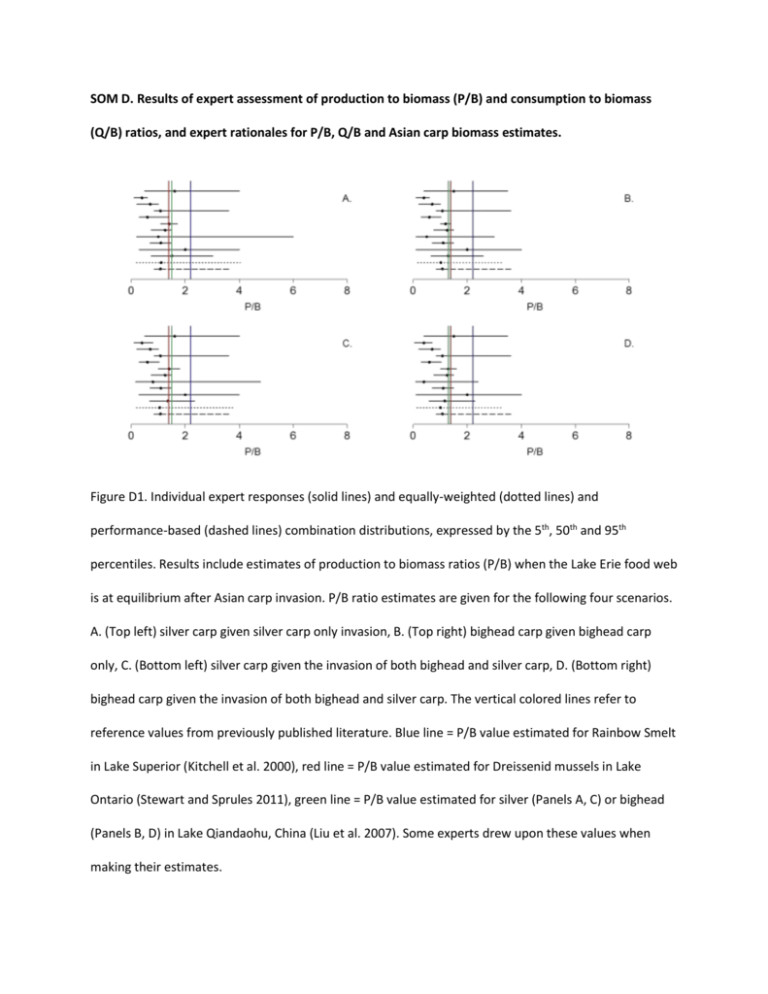
SOM D. Results of expert assessment of production to biomass (P/B) and consumption to biomass (Q/B) ratios, and expert rationales for P/B, Q/B and Asian carp biomass estimates. Figure D1. Individual expert responses (solid lines) and equally-weighted (dotted lines) and performance-based (dashed lines) combination distributions, expressed by the 5th, 50th and 95th percentiles. Results include estimates of production to biomass ratios (P/B) when the Lake Erie food web is at equilibrium after Asian carp invasion. P/B ratio estimates are given for the following four scenarios. A. (Top left) silver carp given silver carp only invasion, B. (Top right) bighead carp given bighead carp only, C. (Bottom left) silver carp given the invasion of both bighead and silver carp, D. (Bottom right) bighead carp given the invasion of both bighead and silver carp. The vertical colored lines refer to reference values from previously published literature. Blue line = P/B value estimated for Rainbow Smelt in Lake Superior (Kitchell et al. 2000), red line = P/B value estimated for Dreissenid mussels in Lake Ontario (Stewart and Sprules 2011), green line = P/B value estimated for silver (Panels A, C) or bighead (Panels B, D) in Lake Qiandaohu, China (Liu et al. 2007). Some experts drew upon these values when making their estimates. Figure D2. Individual expert responses (solid lines) and equally-weighted (dotted lines) and performance-based (dashed lines) combination distributions expressed by the 5th, 50th and 95th percentiles. Results include estimates of consumption to biomass ratios (Q/B) when the Lake Erie food web is at equilibrium after Asian carp invasion. Q/B ratio estimates are given for the following four scenarios. A. (Top left) silver carp given silver carp only invasion, B. (Top right) bighead carp given bighead carp only, C. (Bottom left) silver carp given the invasion of both bighead and silver carp, D. (Bottom right) bighead carp given the invasion of both bighead and silver carp. The vertical colored lines refer to reference values from previously published literature; blue line = Q/B value estimated for Rainbow smelt in Lake Superior (Kitchell et al. 2000), red line = Q/B value estimated for Dreissenid mussels in Lake Ontario (Stewart & Sprules 2011) and green line = Q/B value estimated for silver (Panels A, C) or bighead (Panels B, D) in Lake Qiandaohu, China (Liu et al. 2007). Some experts drew upon these values when making their estimates. Results of P/B and Q/B Ratios Experts' estimated uncertainty ranges (5th, 50th and 95th percentiles) of P/B ratios for all Asian carp invasion scenarios were variable (Figure D1). For the silver carp (only) invasion scenario the EQ combination had both a greater median value and a wider uncertainty range than that of the PB combination. The EQ and PB for P/B ratios of silver carp when bighead carp were also present were highly similar (Figure D1a,b). P/B ratio estimates for bighead carp as the sole invader (Figure D1c,d) had similar uncertainty ranges, but slightly higher median values than those estimated for silver carp as well as for the bighead given bighead+silver invasion scenario. To estimate P/B ratios, nine experts referred to the published literature. Of these nine, 3 experts used published P/B ratio estimates for other Great Lakes fish species (e.g., alewife, bloater) to estimate Asian carp ratios—citing similarities in feeding strategies and ecological pressures. Six experts referred to published bighead carp P/B estimates, adjusting these estimates to reflect expected Asian carp trophic status, harvest rates, and limnological characteristics specific to Lake Erie. All panels of Figure D1 include vertical colored lines that refer to the published values of P/B that some experts used to estimate their responses. Expert estimates of P/B ratios for both silver carp only and silver + bighead carp invasion were almost identical to those estimates for bighead carp alone. Similar to P/B ratios, experts uncertainty ranges for Q/B were variable with individual expert assessments ranging from 0—100 for all scenarios (Figure D2). The PB combination (7.5, 15.15, 27.02) for silver carp given silver carp only invasion was characterized by a higher median value, but narrower uncertainty range than the EQ combination (0.534, 9.048, 59.81) (Figure D2a). The PB combination for the bighead given bighead only invasion Q/B ratio were identical to that of the silver carp given silver carp only scenario, and the EQ combination was only slightly different than the silver carp EQ combination (Figure D2b). Q/B estimates for silver or bighead were essentially unchanged under the scenario where both species invade (Figure D2c,d). To estimate Q/B ratios, most experts again referred to the published literature. All panels of Figure D2 include vertical colored lines that refer to the published values of Q/B that some experts used to estimate their responses. Some experts based responses on combinations of Q/B values estimated for other Lake Erie species such as gizzard shad. Two experts used their estimated P/B ratios (given in the previous section) to derive Q/B ratios, and one expert based his estimates on the published literature and adjusted those values based on personally conducted experimental observations and published measurements of Lake Erie productivity. Three experts estimated identical Q/B ratios for silver and bighead carp, however 8 of 11 experts estimated that Q/B estimates for silver carp will be higher than bighead carp because of differing feeding strategies (e.g., detrivory by silver carp) and food assimilation efficiencies. Discussion of P/B and Q/B Ratios While expert estimates of fish biomass may quantify the magnitude of impact of Asian carp populations in Lake Erie, understanding the ecological mechanisms behind the establishment of an invasive species may provide further insight to the potential impacts on trophic structure and ecosystem functioning. An examination of P/B and Q/B ratios estimated in this study may inform some of these elements and also provide another set of quantities by which to assess potential impacts to Lake Erie biota. For example, the performance-based combination for bighead and silver carp P/B ratios estimated in this study ranged from 0.130-3.762, and Q/B ratios ranged from 0.503-60.83, indicating the potential for Asian carps to have a significant impact on energy transfer between trophic levels in Lake Erie. Typically, P/B ratios are high for plankton (high production, low biomass) and relatively low for fishes (low production, high biomass). For example, for fish populations in lakes, most P/B ratios vary between 0.2- 5.0, are inversely related to maximum fish size and positively correlated with lake productivity (Downing & Plante 1993; Randall & Minns 2000). In an Asian carp-dominated (and stocked) reservoir in China, bighead carp P/B ratios were estimated at 1.299 and silver carp at 1.503, and Q/B were estimated to be 7.53 for bighead and 10.19 for silver (Liu et al. 2007). P/B and Q/B ratio uncertainty ranges estimated by experts in this study indicate that Asian carp may in fact produce or consume, relative to their biomass, at unprecedented rates, potentially causing detrimental perturbations to the Lake Erie food web. Future studies could use the values we report here to investigate (e.g., via the use of food web or trophic interaction modeling) how these bioenergetics ratios affect ecosystem-level functioning. Expert rationales regarding Asian carp biomass estimates According to both the equal weighted and performance-based combination of expert assessments, both bighead and silver carp can successfully establish in Lake Erie with the potential to achieve biomass levels similar to or greater than other Lake Erie taxa. In addition, most experts agreed that Asian carp establishment in Lake Erie is both spatially and temporally dependent, and that the productivity of Lake Erie, particularly in the western basin, would provide an adequate source of energy for both bighead and silver carp. However, the effect on walleye, yellow perch, gizzard shad and rainbow smelt biomass was estimated by experts to be negligible and, in the case of yellow perch, possibly increase whole lake biomass, relative to 2011 as well as long-term averages for these species. This suggests that bighead and silver carp may assimilate into the Lake Erie ecosystem with little, and potentially a positive, effects on the $18.5 million (USD) yellow perch, $6.8 million walleye, $0.7 million rainbow smelt, and $0.06 million gizzard shad binational commercial fisheries (Ontario Ministry of Natural Resources (OMNR) 2011; USGS 2011). Experts expressed a range of opinions about the mechanisms of Asian carp establishment, growth and limitation in Lake Erie. Five experts expect that bighead and silver carp equilibrium biomass will follow a “boom-bust” scenario and will be controlled by food availability and other density dependent effects. One expert specifically noted that predators may eventually switch from current preferred prey to juvenile Asian carps, increasing predation pressure on carp populations impacting trophic interactions. One expert indicated that the limiting factor for Asian carps would be food availability at lower trophic levels (suggesting the influence of bottom-up control), but the same expert stated that top-down control would also be a factor. In contrast, another expert stated that food availability will not limit Asian carp establishment in Lake Erie, but rather recruitment, spawning habitat, and physical factors related to spawning will determine Asian carp population levels. Citing these mechanisms, this expert asserted that Asian carps will establish but maintain populations at low levels, due to a recruitment bottleneck. Three experts expected that bighead and silver carp will not establish in Lake Erie with significant populations, noting that most Lake Erie habitat was not suitable for Asian carp and that the open niche for filter feeders has already been filled by Dreissenid mussels. One expert compared both bighead and silver carp to common carp, stating that they are ecologically similar and that common carp are currently established, but not causing noticeable damage. One expert also referred to scenarios in other lakes (Lake Kinneret, Lake Balaton), concluding that Asian carp do not seem to thrive in large lakes and adding that overwinter mortality may be significant in the GL region. Given our focus on impacts to the biomass of important recreational and commercial species biomass, our results do not quantify the potential effects of Asian carp on angling or other recreational activities. For example, silver carp leaping behavior may alter the recreational experience of personal watercraft users, charter fishing boats, and recreational anglers in the Great Lakes. This impact may be particularly profound in Lake Erie where 43% of annual US Great Lakes recreational angling days occur and 20% of all Canadian Great Lakes anglers allocate their effort (DFO 2005; US Department of Interior (USDOI) 2011). Thus, an assessment of the impacts of Asian carp establishment on other Great Lakes use values is necessary for a complete risk analysis. References DFO. 2005. Survey of Recreational Fishing in Canada Selected Results for the Great Lakes Fishery. Pages 1–64. Ottawa, Ontario. Retrieved from http://www.dfo-mpo.gc.ca. Downing, J. A., and C. Plante. 1993. Production of fish populations in lakes. Canadian Journal of Fisheries and Aquatic Sciences 50:110–120. Kitchell, J. F. et al. 2000. Sustainability of the Lake Superior Fish Community: Interactions in a Food Web Context. Ecosystems 3:545–560. Liu, Q.-G., Y. Chen, L.-Q. Chen, and J.-L. Li. 2007. The food web structure and ecosystem properties of a filter-feeding carps dominated deep reservoir ecosystem. Ecological Modelling 203:279–289. Ontario Ministry of Natural Resources (OMNR). 2011. 2010 Status of Major Stocks. Ontario Ministry of Natural Resources Lake Erie Management Unit. Randall, R. G., and C. K. Minns. 2000. Use of fish production per unit biomass ratios for measuring the productive capacity of fish habitats. Canadian Journal of Fisheries and Aquatic Sciences 57:1657– 1667. Stewart, T. J., and W. G. Sprules. 2011. Carbon-based balanced trophic structure and flows in the offshore Lake Ontario food web before (1987–1991) and after (2001–2005) invasion-induced ecosystem change. Ecological Modelling 222:692–708. US Department of Interior (USDOI). 2011. National Survey of Fishing, Hunting, and Wildlife-Associated Recreation. Pages 1–172. USGS. 2011. Great Lakes Commercial Fishing Reports. Retrieved from http://www.glsc.usgs.gov/.

